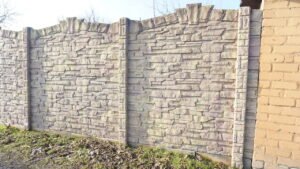Zäune spielen eine entscheidende Rolle, wenn es um die Sicherheit und Privatsphäre Ihres Zuhauses geht, aber sie tragen auch wesentlich zur ästhetischen Anziehungskraft Ihres Grundstücks bei. In diesem Artikel vergleichen wir Holz- und Kunststoffzäune in Bezug auf ihre Vor- und Nachteile, um Ihnen zu helfen, eine informierte Entscheidung zu treffen.
Holzzäune
Holzzäune bieten eine natürliche und traditionelle Begrenzung für viele Gärten und Grundstücke. Sie sind nicht nur funktionell, indem sie Privatsphäre und Sicherheit bieten, sondern sie tragen auch wesentlich zur ästhetischen Gestaltung des Außenbereichs bei. Im Folgenden betrachten wir die Vor- und Nachteile von Holzzäunen, um Ihnen bei der Entscheidung zu helfen, ob ein Holzzaun die richtige Wahl für Ihr Zuhause ist.
Vorteile von Holzzäunen
Holzzäune sind nicht nur praktische Grenzmarkierungen, sondern auch wesentliche Gestaltungselemente in Gärten und Außenbereichen. Sie bieten zahlreiche Vorteile, die sie zu einer beliebten Wahl für viele Hausbesitzer machen. Hier betrachten wir zwei Hauptvorteile: die natürliche Ästhetik und die Umweltfreundlichkeit.
Natürliche Ästhetik
Holz ist bekannt für seine warme, natürliche Schönheit, die es ermöglicht, sich nahtlos in jede Gartenlandschaft einzufügen. Im Vergleich zu anderen Materialien wie Metall oder Kunststoff bietet Holz eine ästhetische Qualität, die oft als traditionell und elegant empfunden wird. Die einzigartige Maserung jedes Holzstücks bedeutet auch, dass kein Zaun dem anderen genau gleicht, was jedem Garten einen individuellen Charakter verleiht. Die natürliche Farbpalette von Holz, von hellen Beigetönen bis hin zu tiefen Braun- und Rottönen, harmoniert perfekt mit einer Vielzahl von Gartenlayouts und Pflanzenfarben. Dieses Material kann auch nach Belieben gestrichen oder gebeizt werden, um bestimmte Farbtöne oder Effekte zu erzielen, was die kreative Gestaltungsfreiheit weiter erhöht.
Umweltfreundlichkeit
Holz ist ein nachwachsender Rohstoff, der, wenn er verantwortungsbewusst beschafft wird, eine umweltfreundlichere Alternative zu synthetischen Materialien wie Kunststoff darstellt. Es ist vollständig biologisch abbaubar und zersetzt sich am Ende seiner Lebensdauer ohne schädliche Rückstände, was es zu einer ausgezeichneten Wahl für umweltbewusste Verbraucher macht. Zudem trägt die Verwendung von Holz aus nachhaltig bewirtschafteten Wäldern dazu bei, die Wiederaufforstung zu fördern und die Biodiversität zu erhalten. Ein weiterer ökologischer Vorteil von Holz ist seine Fähigkeit, Kohlendioxid aus der Atmosphäre zu binden. Während des Wachstums absorbiert ein Baum CO2 und speichert den Kohlenstoff, was zur Reduzierung der Treibhausgasemissionen beiträgt. Selbst wenn Holz als Baumaterial verwendet wird, bleibt dieser Kohlenstoff gebunden, solange das Holz besteht.
Nachteile von Holzzäunen
Obwohl Holzzäune viele Vorteile bieten, gibt es auch einige Nachteile, die berücksichtigt werden sollten, bevor man sich für dieses Material entscheidet. Die Wartung und die Wetteranfälligkeit sind zwei wesentliche Faktoren, die die Langlebigkeit und das Aussehen von Holzzäunen beeinträchtigen können.
Wartungsaufwand
Holzzäune benötigen eine erhebliche Wartung, um ihre Schönheit und Funktionalität über Jahre hinweg zu bewahren. Dazu gehört regelmäßiges Streichen oder Beizen, was nicht nur zeitintensiv ist, sondern auch zusätzliche Kosten für Materialien mit sich bringt. Diese Behandlungen sind notwendig, um das Holz vor Feuchtigkeit und Schädlingen zu schützen, die das Material sonst schnell beschädigen könnten. Die Notwendigkeit einer regelmäßigen Pflege kann besonders in klimatisch herausfordernden Umgebungen zum Nachteil werden, wo extreme Wetterbedingungen häufiger Wartungsarbeiten erfordern. Darüber hinaus kann das Auftragen von Schutzschichten mühsam sein und erfordert eine gewisse Sachkenntnis, um sicherzustellen, dass der Zaun gleichmäßig und effektiv behandelt wird.
Haltbarkeit und Wetteranfälligkeit
Die natürliche Zusammensetzung von Holz macht es anfällig für Wettereinflüsse. Feuchtigkeit ist ein großer Feind von Holzzäunen und kann zu Problemen wie Schimmel, Fäulnis und Verwerfen führen. Besonders in Gebieten mit hoher Luftfeuchtigkeit oder starken Regenfällen kann Holz schnell degenerieren, wenn es nicht angemessen geschützt wird.
UV-Strahlung und andere Elemente der Sonneneinstrahlung können ebenfalls schädlich sein. Sie führen dazu, dass das Holz mit der Zeit ausbleicht und seine Farbe verliert, was regelmäßige Nachbehandlungen notwendig macht, um das ursprüngliche Erscheinungsbild wiederherzustellen. Diese Faktoren begrenzen die Lebensdauer von Holzzäunen erheblich, besonders verglichen mit alternativen Materialien wie Metall oder Kunststoff, die widerstandsfähiger gegenüber Witterungseinflüssen sind. Diese Nachteile sollten gründlich überlegt werden, wenn man die Entscheidung trifft, einen Holzzaun zu installieren. Es ist wichtig, sowohl die kurzfristigen als auch die langfristigen Anforderungen und Kosten für die Wartung zu berücksichtigen, um sicherzustellen, dass diese Wahl mit den persönlichen und praktischen Bedürfnissen übereinstimmt.
Kunststoffzäune
Kunststoffzäune werden immer beliebter, da sie eine praktische und wartungsarme Alternative zu traditionellen Holzzäunen bieten. In diesem Abschnitt werden wir die spezifischen Vorteile und Nachteile von Kunststoffzäunen betrachten, um Ihnen bei der Entscheidung zu helfen, ob sie die richtige Wahl für Ihr Zuhause oder Ihr Projekt sind.
Vorteile von Kunststoffzäunen
Kunststoffzäune stellen eine moderne und zunehmend beliebte Alternative zu traditionellen Materialien wie Holz dar. Sie bieten spezifische Vorteile, die sie besonders attraktiv für Hausbesitzer machen, die nach einer langlebigen und wartungsarmen Lösung suchen. Hier werden die Hauptvorteile von Kunststoffzäunen detailliert betrachtet.
Geringe Wartung
Einer der größten Vorteile von Kunststoffzäunen ist, dass sie extrem wartungsarm sind. Im Gegensatz zu Holzzäunen, die regelmäßig gestrichen oder gebeizt werden müssen, erfordern Kunststoffzäune keine solchen periodischen Behandlungen. Sie sind gegen viele alltägliche Probleme wie Verrotten, Rosten und andere durch Wetterbedingungen verursachte Schäden resistent. Dies spart erheblich Zeit und Geld bei der Instandhaltung, was sie zu einer kosteneffizienten Wahl über die Lebensdauer des Zauns macht. Ihre Pflege beschränkt sich meistens auf gelegentliches Reinigen mit Seifenwasser, um Schmutz und Ablagerungen zu entfernen.
Langlebigkeit
Kunststoffzäune sind bekannt für ihre Langlebigkeit. Sie sind aus Materialien hergestellt, die weder verblassen noch sich verziehen oder verrotten, selbst unter rauen Wetterbedingungen. Diese Beständigkeit gegenüber Umwelteinflüssen macht sie zu einer sehr dauerhaften Lösung für jede Immobilie. Ihre Farbe und Struktur bleibt über Jahre hinweg erhalten, ohne dass die Notwendigkeit besteht, sie zu erneuern oder auszutauschen. Dies ist besonders vorteilhaft in Regionen mit extremen Wetterbedingungen, wo andere Materialien schnell altern oder beschädigt werden können.
Nachteile von Kunststoffzäunen
Kunststoffzäune bieten zwar viele praktische Vorteile, jedoch gibt es auch einige Nachteile, die potenzielle Käufer berücksichtigen sollten. Diese Nachteile umfassen Umweltbedenken sowie eingeschränkte Designoptionen, die die Wahl von Kunststoffzäunen als Lösung für manche Bedürfnisse weniger attraktiv machen könnten.
Umweltbedenken
Einer der größten Nachteile von Kunststoffzäunen ist ihre Umweltauswirkung. Kunststoff ist nicht biologisch abbaubar, was bedeutet, dass er nicht auf natürliche Weise in der Umwelt zerfällt. Die Entsorgung von Kunststoffprodukten kann somit langfristige Umweltprobleme verursachen. Zusätzlich kann die Herstellung von Kunststoffzäunen umweltschädlich sein, insbesondere wenn sie unter Einsatz von nicht recycelten Materialien erfolgt. Die Produktion erfordert erhebliche Mengen an Energie und Ressourcen und kann zur Freisetzung von schädlichen Chemikalien führen, die sowohl die Luft als auch Wasserquellen belasten.
Eingeschränkte Designoptionen
Obwohl die Technologie in der Herstellung von Kunststoffzäunen stetig fortschreitet und mehr Designmöglichkeiten geschaffen werden, bieten sie oft nicht die gleiche Vielfalt an Stilen und Farben wie Holzzäune. Viele Kunststoffzäune tendieren dazu, ein eher uniformes und manchmal künstliches Aussehen zu haben, was sie für Hausbesitzer weniger wünschenswert machen kann, die einen natürlicheren oder individuelleren Stil bevorzugen. Während einige Kunststoffzäune so gestaltet sind, dass sie Holz imitieren, erreichen sie oft nicht die Feinheiten von natürlichen Holzmaserungen und Farbvariationen.
Vergleich der Kosten
Die Entscheidung zwischen Holz- und Kunststoffzäunen sollte nicht nur auf ästhetischen Präferenzen basieren, sondern auch die Kostenaspekte berücksichtigen. Hierbei ist es wichtig, sowohl die Anschaffungskosten als auch die langfristigen Unterhaltungskosten zu vergleichen, um eine fundierte Entscheidung treffen zu können.
Anschaffungskosten
Holzzäune sind in der Anschaffung oft günstiger als Kunststoffzäune. Die Kosten können jedoch je nach Holzart stark variieren. Weichhölzer wie Kiefer oder Tanne sind in der Regel kostengünstiger als Harthölzer wie Eiche oder Mahagoni. Die Wahl des Holzes beeinflusst somit nicht nur das Aussehen und die Langlebigkeit des Zauns, sondern auch den Anschaffungspreis. Diese Preisdifferenz macht Holzzäune für viele Budgetbewusste attraktiv, insbesondere wenn sie eine preisgünstige Lösung suchen oder eine große Fläche einzäunen möchten.
Langzeitkosten
Obwohl Kunststoffzäune in der Anschaffung meist teurer sind als Holzzäune, können sie langfristig kosteneffizienter sein. Dies liegt vor allem an den geringeren Wartungsanforderungen. Kunststoffzäune müssen nicht gestrichen oder gebeizt werden und sind widerstandsfähig gegen Verrotten, Rosten und andere Witterungseinflüsse, die regelmäßige Reparaturen oder Ersatz erforderlich machen könnten. Diese langfristige Kostenersparnis kann die höheren Anfangsinvestitionen ausgleichen, besonders wenn man die Zeit und das Geld berücksichtigt, die für die Instandhaltung eines Holzzauns aufgewendet werden müssen.
Einfluss auf den Immobilienwert
Die Art des Zauns, den man für sein Grundstück wählt, kann signifikante Auswirkungen auf den Immobilienwert haben. Sowohl Holz- als auch Kunststoffzäune bieten Vorteile, die sich positiv auf die Attraktivität und den Marktwert einer Immobilie auswirken können. Entscheidend ist, wie gut der Zaun gepflegt wird und ob sein Stil harmonisch zum Gesamtbild des Hauses passt.
Auswirkungen von Holzzäunen
Holzzäune sind nicht nur funktional, sondern können auch ästhetisch ansprechend sein und somit den Wert einer Immobilie steigern. Ein gut gepflegter Holzzaun, der stilistisch zum Haus passt, trägt zur visuellen Anziehungskraft und zum Charakter des Grundstücks bei. Die natürliche Schönheit des Holzes und seine traditionelle Ausstrahlung können besonders in Gegenden, in denen Holzbau vorherrscht oder historische Genauigkeit geschätzt wird, sehr wertvoll sein. Investitionen in regelmäßige Pflege und hochwertige Materialien können den Wiederverkaufswert des Hauses erhöhen, da potenzielle Käufer oft bereit sind, mehr für Immobilien zu zahlen, die eine ansprechende äußere Erscheinung bieten.
Auswirkungen von Kunststoffzäunen
Kunststoffzäune sind in der modernen Immobilienlandschaft zunehmend beliebt, besonders in neueren Wohngegenden, wo Langlebigkeit und geringe Wartung geschätzt werden. Sie bieten eine saubere, gepflegte Erscheinung, die über Jahre hinweg mit minimaler Wartung erhalten bleibt. Dies kann besonders attraktiv für Käufer sein, die eine pflegeleichte Option suchen. In Gebieten, in denen moderne Bauweisen vorherrschen, können Kunststoffzäune den Immobilienwert steigern, indem sie eine zeitgemäße Ästhetik unterstützen, die mit der allgemeinen Architektur und dem Design des Wohngebiets harmoniert.
Umweltüberlegungen
Bei der Wahl des Materials für einen neuen Zaun spielen Umweltüberlegungen eine immer größere Rolle. Sowohl Holz- als auch Kunststoffzäune haben spezifische Umweltauswirkungen, die berücksichtigt werden sollten. Nachhaltigkeit bei der Materialwahl und Recyclingmöglichkeiten sind wichtige Faktoren, die die Umweltbelastung eines Zaunprojekts beeinflussen können.
Nachhaltigkeit von Holzmaterialien
Die Entscheidung für Holz aus nachhaltiger Forstwirtschaft ist entscheidend, um die Umweltverträglichkeit eines Holzzauns zu gewährleisten. Holz aus nachhaltig bewirtschafteten Wäldern wird so geerntet, dass die Wiederherstellung der Waldflächen gewährleistet ist und die Biodiversität erhalten bleibt. Dies minimiert den ökologischen Fußabdruck und unterstützt das ökologische Gleichgewicht. Zertifizierungen wie FSC (Forest Stewardship Council) oder PEFC (Programme for the Endorsement of Forest Certification) bieten Sicherheit darüber, dass das verwendete Holz nach strengen ökologischen, sozialen und wirtschaftlichen Standards produziert wurde. Durch die Wahl zertifizierten Holzes tragen Hausbesitzer direkt zum Umweltschutz und zur Förderung nachhaltiger Waldwirtschaft bei.
Recycling von Kunststoffzäunen
Kunststoffzäune bieten den Vorteil, dass sie am Ende ihrer Lebensdauer recycelt werden können, was dazu beiträgt, ihre Umweltbelastung zu reduzieren. Das Recycling von Kunststoffen kann jedoch von der Verfügbarkeit lokaler Recyclingprogramme abhängen. In Regionen, in denen solche Programme gut ausgebaut sind, kann Kunststoff effektiv wiederverwertet werden, um neue Produkte herzustellen, was die Notwendigkeit der Neuproduktion von Kunststoffen und damit verbundene Umweltbelastungen verringert. Es ist wichtig, sich bei der Entscheidung für einen Kunststoffzaun über die lokalen Recyclingmöglichkeiten zu informieren und Materialien zu wählen, die bekanntermaßen gut recycelbar sind.
Der ideale Lamellenzaun für Ihren Garten: Holz oder Kunststoff?
Sind Sie auf der Suche nach dem perfekten Lamellenzaun für Ihren Garten, aber unsicher, ob Holz oder Kunststoff die bessere Wahl ist? Besuchen Sie PolenDiscount.de, füllen Sie das Formular aus und erhalten Sie Angebote von mehreren Fachspezialisten aus Polen. Machen Sie den ersten Schritt zu Ihrem Traumzaun!
Mit PolenDiscount.de schnell und zuverlässig zu Ihrem neuen Zaun
Fazit
Die Wahl zwischen einem Holz- und einem Kunststoffzaun hängt von vielen Faktoren ab, einschließlich persönlicher Präferenzen, Budget, Wartungsbereitschaft und Umweltbewusstsein. Es ist wichtig, alle Aspekte zu berücksichtigen, um die beste Entscheidung für Ihr Zuhause und Ihre Umgebung zu treffen.






